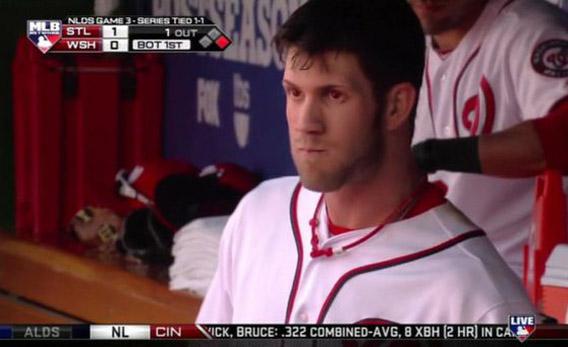Washington Nationals outfielder Bryce Harper wore a pair of red-tinted contact lenses in a playoff game Wednesday. Do tinted contacts make any difference?
Probably not much. So-called performance-tinted contacts make two separate claims. The first is that they reduce glare, just like eye black or ordinary sunglasses. In this regard, it’s pretty clear the contacts deliver. The second claim, that they make target objects like baseballs visually “pop” by filtering out certain wavelengths of light, is more controversial. In a 2007 experiment, college and professional football players were fitted with both clear and tinted lenses, and then asked to pick out a series of curved lines that blended with increasing subtlety into a blurred, visually-noisy background. The players wearing amber-tinted lenses performed better in the laboratory, suggesting that the contacts made good on their marketing claims. The author of the study, however, questioned whether the lenses would make any practical difference. The experiment was designed to detect tiny changes in visual acuity, and that’s basically what the tinted contacts produced: tiny, but statistically significant, changes. Existing research suggests that a higher level of improvement must be achieved in the laboratory to expect to draw real-world vision benefits, and the performance-tinted lenses failed to meet that threshold in this experiment. There have been a handful of other studies in which the lenses have fared either slightly better or slightly worse. In the end, it’s tough to draw firm conclusions about tinted contacts.
Harper is far from the first athlete to experiment with tinted eyewear. Mark McGwire was a big proponent, and competitive sharpshooters have long worn amber-tinted glasses to help them spot clay targets. But these endorsements are anecdotal, and the athletes may benefit more from the anti-glare effects than the wavelength-filtration. (In most studies, the participants say they like the performance-tinted lenses, even when the experiments suggest they’re making very little difference.)
One thing is clear: The new generation of performance-tinted contacts is an improvement on earlier models. In 2001, a study showed that lenses specifically tinted for tennis players actually made the ball more difficult to see.
Got a question about today’s news? Ask the Explainer.
